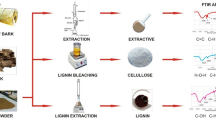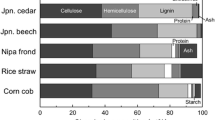Abstract
A series of tree products was tested for carboxyl ester groups, since they can be esaily transformed into acid groups which are important and required in uses such as some gluing processes and cation exchange. Materials taken into consideration, besides wood, were bark, leaves and remains or shells of fruit of some hardwoods and softwoods. As overall average, esters contribute to about half of the total content of carboxyls. In detail the contribution of esters varies with the material. Wood takes first place in this group and the amount of esters is larger in softwoods than in hardwoods. Bark seems to follow the same trend for the corresponding wood. Both leaves and fruit exhibit a varyied and sometimes interesting amount of esters.
Zusammenfassung
Holz, Rinden, Blätter und Früchte verschiedener Baumarten wurden auf ihren Gehalt an Carboxylestergruppen untersucht. Estergruppen können sich leicht in Säuregruppen umwandeln, die für die industrielle Nutzung wie Verleimung oder Ionenaustauscher von Bedeutung sind. Im Durchschnitt wird etwa die Hälfte aller Carboxylgruppen von Estern gebildet. Im Einzelnen ist der Anteil der Ester jedoch sehr unterschiedlich je nach Art des Materials. Bei Hölzern ist dieser Anteil am höchsten, darunter bei Nadelhölzern höher als bei Laubhölzern. Die Rinden lassen etwa die gleiche Tendenz erkennen. Blätter und Früchte zeigen sehr unterschiedliche und oft interessante Anteile an Estergruppen.
Similar content being viewed by others
References
Anonymous 1970: (Technical Association of Pulp and Paper Industry), TAPPI standard and suggested methods. New York
Back, E. L.;Danielsson, S. 1987: Oxidative activation of wood and paper surfaces for bonding and for painting adhesions. Nordic Pulp and Paper Res. J. Spec. Issue 2: 53–62.
Back, E. L. 1991. Oxydative activation of wood surfaces for glue bonding. Forest Prod. J. 41(2): 30–36.
Landi, L.;Staccioli, G. 1992: Acidity of wood and bark. Holz Roh-Werkstoff 50(6): 238
Matteoli, U.;Menchi, G.;Staccioli, G.;Tamburini, U. 1992: Acid groups in wood as shown using selective reduction. Holz Roh-Werkstoff 50(11): 438–440.
Nussbaum, R. M. 1993: Oxidative activation of wood surfaces by flame treatment. Wood Sci. Technol. 27: 173–182.
Placek, C. 1970: Ion Exchanger Resins Noyes Data Corporation New Jersey
Subramanian, R. V.;Somasekharan, K. N.;Johns, W. E. 1983: Acidity of wood. Holzforschung 37(3):117–120
Staccioli, G.;Tamburini, U. 1990: Free carboxyl groups in wood. Holz Roh-Werkstoff 48: 384.
Author information
Authors and Affiliations
Additional information
Dedicated to Prof. Dr. D. Fengel on occasion of his retirement
Rights and permissions
About this article
Cite this article
Staccioli, G., Menchi, G. & Matteoli, U. Occurrence and importance of carboxyl ester groups in some lignocellulosic materials. Holz als Roh-und Werkstoff 52, 215–217 (1994). https://doi.org/10.1007/BF02619094
Issue Date:
DOI: https://doi.org/10.1007/BF02619094




